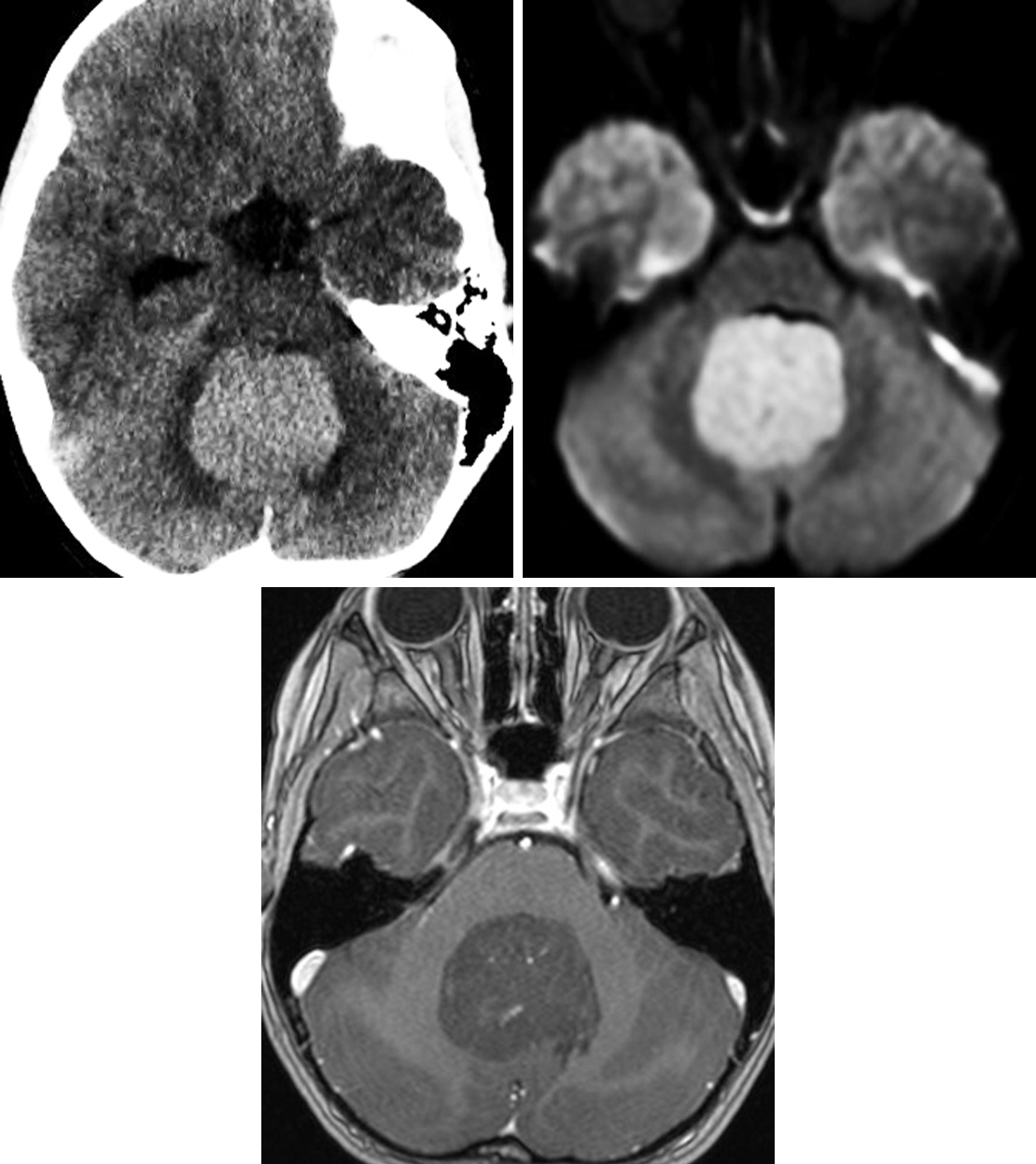Medulloblastoma
Figure 1: (Top Left) The hyperdensity of this medulloblastoma on CT imaging is typical and representative of the tumor's hypercellularity. (Top Right) Likewise, DWI shows restricted diffusion, also representing hypercellularity. (Bottom) The patient's lack of significant enhancement on this T1-weighted postcontrast image is most typical of group 4 medulloblastomas. The intraventricular location is also typical, with these lesions sometimes visibly arising from the fourth ventricular roof.
Figure 2: Sagittal T1 postcontrast (top left), axial T2-FS (top right), DWI (middle left), and ADC (middle right) images demonstrate an enhancing mass in the fourth ventricle with restricted diffusion (bright on DWI and dark on ADC) compatible with a hypercellular tumor. Multiple enhancing supratentorial and infratentorial nodules are noted along the surface of the cerebrum and cerebellum (top left), compatible with CSF dissemination of the tumor. (Bottom Left and Bottom Right) Sagittal T1 postcontrast images of the cervical, thoracic, and lumbar spine demonstrate enhancing nodules along the dorsal surface of the spinal cord compatible with drop metastases in this patient with aggressive medulloblastoma.
BASIC DESCRIPTION
- Malignant, invasive primitive neuroectodermal tumor usually arising within the posterior fossa
- Most common pediatric malignant posterior fossa tumor
PATHOLOGY
- WHO grade IV
- Divided into 4 molecular subtypes that originate in different locations:
- Wingless (WNT): cerebellar peduncles, cerebellopontine angle (CPA) cistern
- Sonic hedgehog (SHH): cerebellar hemispheres
- Group 3: fourth ventricle, midline
- Group 4: fourth ventricle, midline
- Divided into 4 distinct histologic subtypes: classic (most common), desmoplastic, large cell/anaplastic, and extensive nodularity
CLINICAL FEATURES
- Most commonly afflicts children aged 5 to 12 years; adult cases are rare
- Common presenting signs/symptoms are related to increased intracranial pressure/hydrocephalus
- Headache, nausea, vomiting, altered mental status, papilledema, macrocephaly
- Treatment: surgical resection ± adjuvant chemoradiation
- Prognosis varies with molecular subtype and histology:
- Wingless most favorable
- Group 3 least favorable
IMAGING FEATURES
- General
- Appearance varies with location/subtype
- Solid, rounded fourth ventricular mass most common
- ±Fourth ventricular effacement and distortion (in comparison with ependymoma, which often expands/enlarges the fourth ventricle)
- Calcification and cysts occasionally present
- Hemorrhage uncommon
- Cerebrospinal fluid (CSF) dissemination common, including drop metastases within the spinal canal (15%–50%)
- CT
- Fairly homogeneous, mildly hyperdense fourth ventricular mass
- ±Hyperdense calcifications or hypodense cysts
- Variable enhancement on contrast-enhanced CT imaging (patchy or homogeneous)
- MRI
- T1WI: hypointense
- T2WI: isointense to hyperintense
- FLAIR: improved delineation of tumor and CSF; minimal peritumoral edema
- T1WI+C: majority show heterogeneous enhancement, although variable patterns exist; may see CSF dissemination throughout neuraxis
- DWI: demonstrates DWI-bright, ADC-dark diffusion restriction
- MRS: elevated Cho, decreased NAA, ± lactate peak
IMAGING RECOMMENDATIONS
- MRI without and with intravenous contrast including both brain and spine due to risk of CSF dissemination
For more information, please see the corresponding chapter in Radiopaedia.
Contributors: Rachel Seltman, MD, and Jacob A. Eitel, MD
References
Brandes AA, Bartolotti M, Marucci G, et al. New perspectives in the treatment of adult medulloblastoma in the era of molecular oncology. Crit Rev Oncol Hematol 2015;94:348–359. doi.org/10.1016/j.critrevonc.2014.12.016.
Gerber NU, Mynarek M, von Hoff K, et al. Recent developments and current concepts in medulloblastoma. Cancer Treat Rev 2014;40:356–365. doi.org/10.1016/j.ctrv.2013.11.010.
Koral K, Gargan L, Bowers DC, et al. Imaging characteristics of atypical teratoid-rhabdoid tumor in children compared with medulloblastoma. AJR Am J Roentgenol 2008;190:809–814. doi.org/10.2214/AJR.07.3069.
Osborn AG, Salzman KL, Jhaveri MD. Diagnostic Imaging (3rd ed). Elsevier, Philadelphia, PA; 2016.
Yeom KW, Mobley BC, Lober RM, et al. Distinctive MRI features of pediatric medulloblastoma subtypes. AJR Am J Roentgenol 2013;200:895–903. doi.org/10.2214/AJR.12.9249.
Please login to post a comment.














